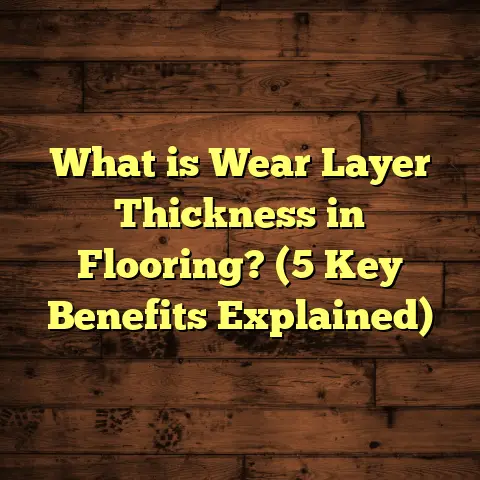What is Ceramic Tile Flooring? (5 Key Benefits for Your Home)
Here is the expanded version following your instructions:
Ever tried explaining ceramic tile flooring to someone who thinks it’s just fancy bathroom stuff? I once told my neighbor, “It’s like the superhero of floors—durable, stylish, and ready to fight off spills and stains.” She looked at me like I’d lost it. But seriously, ceramic tile flooring is way more than just a pretty surface; it’s a game-changer for your home.
I’ve been in the flooring business for years, and ceramic tile has always had a special place in my toolkit. Whether it’s a small bathroom makeover or an entire kitchen renovation, ceramic tile often steals the show. Let me walk you through what makes it so special.
What is Ceramic Tile Flooring?
So, what exactly is ceramic tile flooring? At its core, ceramic tile is a floor covering made from natural clay that has been shaped and fired at high temperatures in a kiln. This process hardens the clay into a strong, durable tile that’s perfect for all kinds of spaces.
You might wonder about the difference between ceramic and porcelain tiles. Here’s the scoop: porcelain tiles are a type of ceramic tile but are fired at even higher temperatures, making them denser and more water-resistant. Porcelain tends to be a bit more expensive but also more durable—great for high-traffic areas or even outdoor use.
Ceramic tiles come in two major types: glazed and unglazed. Glazed tiles have a glass-like coating that gives them color and shine while protecting the surface from stains and scratches. Unglazed tiles, often called quarry tiles, have a natural finish and tend to be more slip-resistant but require sealing to prevent stains.
The Making Process
The manufacturing process tells you a lot about why ceramic tiles perform so well. Clay is mined from the earth and then mixed with other natural materials like sand and feldspar. This mixture is molded into shapes using molds or extrusion methods.
After shaping, the tiles go into a kiln heated between 1,000°C to 1,200°C (1,832°F to 2,192°F). This intense heat vitrifies the clay, meaning it turns essentially into glass. This vitrification is what gives ceramic tiles their hardness and makes them resistant to water absorption.
Once cooled, glazed tiles receive their coating and are fired again to fuse the glaze onto the tile surface. This glaze can be matte, glossy, or textured depending on design preferences.
Varieties of Ceramic Tiles
Ceramic tiles come in so many varieties that choosing the right type can feel overwhelming. You’ll find everything from tiny mosaic tiles perfect for backsplashes to large-format tiles that cover big floors without many grout lines.
Some popular finishes include:
- Glossy: Reflects light beautifully but can be slippery.
- Matte: Offers a modern look with less shine and better grip.
- Textured: Great for wet areas or outdoor patios to prevent slipping.
- Patterned: Printed or hand-painted designs for artistic flair.
Sizes vary from small 1×1 inch mosaics to massive 24×24 inch slabs. Thickness usually ranges from 6mm to 10mm for residential tiles.
My Early Experience With Ceramic Tile
When I first started out as a contractor, I installed ceramic tile in a small cafe kitchen. The owners wanted something durable yet attractive enough to impress customers who peeked into the prep area. I recommended glazed ceramic tiles with a light gray tone that masked dirt but brightened the space.
Months later, they told me how easy cleanup was after busy mornings filled with coffee spills and food messes. It was one of those jobs where the client’s satisfaction made me really appreciate ceramic tile’s benefits firsthand.
5 Key Benefits of Ceramic Tile Flooring for Your Home
Now that you know what ceramic tile flooring is, let me share five key benefits that have convinced countless homeowners (and me) that this flooring is worth every penny.
1. Durability That Lasts Decades
Hands down, durability is the biggest reason I push ceramic tile in my projects. Floors take a beating every day—kids running around, pets scratching, furniture moving—and ceramic handles it like a champ.
In one project for a family with two young kids and a large dog, I installed porcelain ceramic tiles in their living room and kitchen. After four years of heavy use, the floor showed zero signs of wear. No scratches or chips. Plus, the grout lines were still clean because they chose an epoxy grout option.
Let’s talk numbers: according to the Tile Council of North America (TCNA), properly installed ceramic tile can last 50 years or more without needing replacement. Compare that with hardwood floors which may need refinishing every 7-10 years or laminate floors which often last 10-20 years at best.
Additionally, ceramic tiles resist dents and scratches better than most wood floors. They’re also fire-resistant and don’t warp with moisture changes—a huge plus if you live in humid areas or near kitchens and bathrooms.
For commercial spaces like restaurants or hotels where foot traffic is intense, many rely on porcelain ceramic tiles because they hold up under constant use.
Pro Tip: Always check the PEI rating when buying tiles. For most home areas like kitchens and hallways, a PEI rating of 3 or higher ensures good wear resistance. High-traffic areas might benefit from PEI 4 or 5 rated tiles.
2. Easy Maintenance – Because Who Has Time?
Do you like spending hours scrubbing floors? Me neither. One reason homeowners love ceramic tile is how easy it is to take care of.
Ceramic tile doesn’t absorb liquids thanks to its low porosity (usually less than 3%). This means spills wipe right off without staining if cleaned quickly—which is perfect for homes with kids or frequent cooks.
In one of my recent jobs—a busy café kitchen—the staff told me how simple cleanup was after daily spills of coffee, wine, and sauces. No sticky messes clinging to the floor!
Routine cleaning only requires sweeping or vacuuming to remove dirt and dust followed by damp mopping with mild soap or specialized tile cleaners. Unlike carpet that traps allergens and dirt deep down or wood that needs polishing and careful water control, ceramic tiles stand up well to everyday cleaning.
For grout maintenance, sealing every 1-2 years keeps stains away and prolongs grout life. I always recommend epoxy grout if budget allows—it’s more stain-resistant than traditional cement-based grout.
Did You Know? According to a Houzz survey of homeowners, those with ceramic tile floors reported spending 25% less time on floor maintenance compared to those with wood or carpet floors.
3. Aesthetic Flexibility to Match Your Style
If you’re someone who loves decorating your home frequently or wants a unique look, ceramic tile has you covered.
The style options are practically endless—from classic white subway tiles perfect for clean modern kitchens to vividly patterned Spanish or Moroccan designs that add character.
A personal favorite story: A client loved rustic wood floors but needed something practical for their kitchen because of kids and pets. We found wood-look ceramic tiles crafted with realistic grain patterns and warm tones. The floor looked cozy but didn’t scratch or stain like wood would have after several years.
Thanks to advances in printing technology, manufacturers can now produce photo-realistic finishes on tiles mimicking marble, stone, wood, concrete—you name it.
Sizes vary too; large format tiles reduce grout lines for a sleeker look while smaller mosaics highlight backsplashes or create artistic borders.
For bathrooms or feature walls, decorative encaustic-style tiles are making a comeback—mixing colors and patterns for bold statements.
With thousands of choices available online or at showrooms, there’s no shortage of ways to express your style through ceramic flooring.
4. Hypoallergenic Properties
If allergies run in your family like mine do, this one matters a lot.
Ceramic tile doesn’t harbor dust mites, pet dander, pollen, or mold spores like carpets do. It’s hard surface cleaning combined with low moisture absorption keeps allergens at bay.
One memorable project was for a family whose daughter had severe asthma triggered by carpet fibers and dust buildup. After switching their living room floors to ceramic tile with an area rug they could wash regularly, her symptoms improved significantly during visits.
The Asthma and Allergy Foundation of America supports hard surface flooring options like ceramic because they reduce indoor allergens by trapping fewer particulates than soft flooring materials.
In addition to health benefits, this means fewer sneezes and less dusting overall!
5. Energy Efficiency and Cooling Effect
If you live somewhere hot—or just want a naturally cool floor—ceramic tile helps keep your home comfortable without cranking up the AC.
During summer months where I live, temperatures easily hit above 90°F (32°C). Ceramic tile floors stay cool underfoot compared to carpet or wood surfaces which absorb heat.
Research shows homes with tile flooring can save up to 10% on cooling costs during hot months thanks to better thermal conductivity—meaning heat escapes faster through the floor helping keep rooms cooler.
On the flip side, if your winters get chilly, pairing ceramic tile with radiant underfloor heating offers an energy-efficient way to stay warm while enjoying easy-to-clean floors.
Installation Insights From My Years on the Job
Ceramic tile installation isn’t exactly “plug-and-play.” It requires skill and attention to detail for best results. Let me share some tips from my experience working on hundreds of installations:
Preparing the Subfloor
Proper subfloor prep is everything. The surface must be clean, flat, and stable. Uneven floors cause cracking over time—a nightmare I’ve seen too many times when shortcuts were taken.
For concrete subfloors, cracks should be filled; wood subfloors need cement backer board installed for stability because direct installation on wood can lead to loosening or cracking.
Layout Planning
Planning your layout saves headaches later. Starting from the room’s center helps achieve symmetrical cuts at edges which look better visually than random partial tiles.
I always advise clients to bring samples home first so they can see how lighting affects color before finalizing orders.
Cutting Tiles
Using quality wet saws makes clean cuts that fit perfectly around corners or fixtures without chipping edges. It’s worth investing here rather than risking broken pieces during installation.
Grouting
Choosing grout color affects appearance greatly. Darker grout hides dirt but can make spaces look smaller; lighter grout brightens rooms but shows stains easier unless sealed well.
Epoxy grout costs more but resists stains far better than cement-based varieties—ideal for kitchens or bathrooms prone to spills.
Time Frame
Installation speed depends on room size but usually takes several days including drying time between steps like thinset application and grouting.
Rushing can cause mistakes like uneven tiles or weak adhesion—never cut corners here!
Maintenance Tips To Make Your Ceramic Tile Floors Shine
Owning ceramic tile floors means less upkeep overall but keeping them looking great still needs some care:
- Sweep daily or vacuum regularly to remove grit that scratches surfaces.
- Mop weekly with pH-neutral cleaners designed for tile.
- Avoid harsh chemicals like bleach which can dull glaze.
- Seal grout lines every couple of years—or sooner if exposed to heavy traffic.
- Promptly clean spills to avoid grout stains.
- Use rugs in entryways to trap dirt before it reaches your floor.
- For textured tiles prone to trapping dirt in grooves, use soft brushes during cleaning.
Cost Factors: What Should You Expect?
Budgeting for ceramic tile flooring depends on several factors:
- Material costs: Basic glazed ceramic tiles can start as low as $1-$3 per sq ft; high-end porcelain or designer patterns range $5-$15+ per sq ft.
- Installation: Professional labor varies widely but expect $4-$10 per sq ft depending on complexity.
- Preparation: Subfloor repairs may add extra costs.
- Grout type: Epoxy grouts add upfront cost but save money long-term.
- Additional features: Underfloor heating systems increase budget too.
In my experience helping clients budget projects using tools like FloorTally ensures no surprises pop up halfway through installation.
Though initial costs might seem higher than laminate or vinyl options, consider longevity—ceramic lasts decades with minimal upkeep versus laminate needing replacement in under ten years sometimes.
Trends That Are Changing Ceramic Tile Flooring Today
The industry keeps evolving:
- Large-format tiles: Bigger sizes reduce grout lines creating sleek looks popular in modern homes.
- Wood-look ceramics: Combining warmth of wood aesthetics with durability of tile.
- Patterned encaustic-style: Bold designs inspired by traditional Mediterranean styles are making comebacks.
- Matte finishes: Less slippery surfaces preferred especially for wet areas.
- Eco-friendly production: Some brands now offer recycled content options reducing environmental impact.
More Stories From The Field: Real-Life Examples
One client wanted a pet-friendly kitchen since their two Labradors constantly tracked dirt inside. We went with textured unglazed porcelain tiles with dark grout—cleaned effortlessly and resisted scratches despite rough paws running in daily.
Another homeowner needed accessible flooring after breaking a hip; ceramic tiles offered smooth surfaces compatible with walkers while being easy to clean—helping them maintain independence longer without worries about slipping.
Final Thoughts (Without Saying “In Conclusion”)
Ceramic tile flooring offers durability, style flexibility, easy maintenance, allergy relief benefits, and energy efficiency that few other materials can match. It suits a wide range of lifestyles—from busy families juggling messes to allergy sufferers seeking cleaner environments.
If you’re thinking about upgrading your floors anytime soon, consider ceramic tile as not just an option but potentially the best investment you make for your home’s comfort and value over time.
Got questions about your own project? I’m here anytime to chat about what works best based on your needs!





